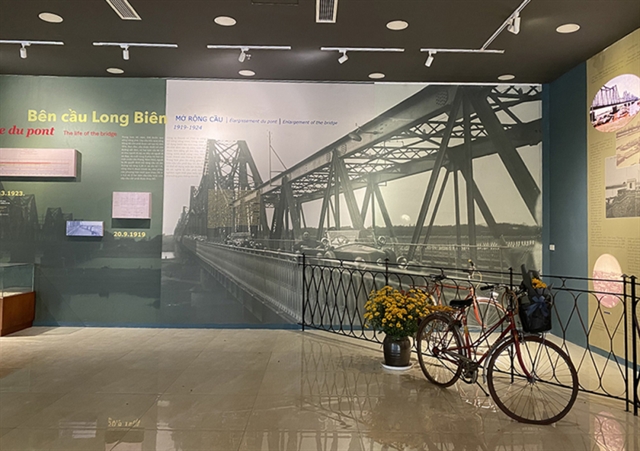HÀ NỘI — A collection of old documents related to Hà Nội’s iconic Long Biên Bridge has been unveiled to the public for the first time.
More than 100 documents, including sketches and images of the bridge that were taken from 1898 to 1975, are on display at an on-going exhibition at the National Archives Centre 1 in Hà Nội.

Visitors enjoy photos of the Long Biên Bridge that were taken by Vietnamese and foreign photographers at the exhibition ‘Long Biên Bridge – The Eyewitness of History’. — Photo dangcongsan.vn
Entitled Cầu Long Biên Nhân Chứng Lịch Sử (Long Biên Bridge – The Eyewitness of History), the exhibition, has been co-organised by the National Archives Centre 1 and the École française d'Extrême-Orient (EFEO or the French School of Asian Studies) to celebrate the 120th anniversary of the iconic bridge.
The documents and images show details how the bridge was built, expanded and renovated. The life of people living in a Red River mudflats under the bridge also were depicted in several images.
Among the documents and images are on display, some are on loan from the French Overseas National Archives (ANOM).
The objects include a construction bidding registration approved by the French Governor-General of Indochina, Paul Doumer. The drawings of the bridge’s façade and longitudinal section by the French contractor Daydé & Pillé Company are also on display.

A photo is on display at the exhibition. — Photo courtesy of the National Archives Centre 1
Visitors can enjoy the exhibition which has been set up following three major contents: The Bridge Was Built from a Crazy Idea, By the Long Biên Bridge, and Memory of the Long Biên Bridge.
Alongside the old documents and images, the exhibition was also enriched by photographs that were taken by Vietnamese and foreign photographers.
To create a lively and diversified displaying space, the organisers also set up a small model of the Long Biên Bridge as the background for anyone who are interested in photography. Alongside, junior visitors can present their art ability by drawing paintings at a creative corner.
Visiting the exhibition, French Ambassador to Việt Nam Nicolas Warnery said that the landmark bridge is a construction that symbols for the relationship of the two countries.
“It also conveys the common memories of Việt Nam-France history,” he said. “Therefore, the organisation of this exhibition is to present comprehensively to the public the image of Long Biên Bridge throughout the length of history.”

The exhibition is to celebrate the 120th anniversary of the iconic bridge. — Photo cand.com.vn
On September 13, 1889, Governor-General Doumer held a ground-breaking ceremony for a bridge crossing the Hồng (Red) River. The bridge was designed in the style of the keys that the contractor Daydé & Pillé Company applied for the first time to Tolbiac Bridge in Paris. It has a length of 1,862m, consisting of 19 steel beams and a stone path. There is a single railroad track for trains in the middle and both sides have pathways for motorised vehicles and pedestrians.
The construction of the first steel bridge in Việt Nam was the fourth-largest and the second-longest of its kind in the world at the time, after the Brooklyn Bridge in the US.
The bridge was officially inaugurated on February 28, 1902, after nearly three years and nine months of construction, and was named after Paul Doumer, the French Governor-General of Indochina. It was renamed Long Biên following Việt Nam gained independence in 1945.
The exhibition Long Biên Bridge – The Eyewitness of History opens until mid-June of 2023. — VNS